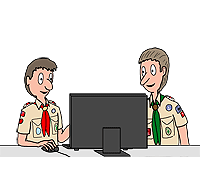
SWIMMING
Either this Merit Badge
or Hiking MB or Cycling MB
is Required to earn the Eagle Scout Rank
Until April 1, 1999, either this Merit Badge
or Personal Fitness MB or Sports MB
was Required to earn the Eagle Scout Rank
REQUIREMENTS were Completely REVISED as of January
1, 2001.
Click Here for the OLD
requirements.
These REQUIREMENTS were in effect from January 1 through
December 31, 2001.
To see the current requirements
Click Here
- Show that you know first aid for injuries or illnesses that
could occur while swimming, including hypothermia, heat reactions,
muscle cramps, sunburn, stings, cuts and scrapes, spinal injuries,
and hyperventilation.
- Do the following:
- Identify the conditions that must exist before performing
CPR on a person. Explain how such conditions are recognized.
- Demonstrate proper technique for performing CPR using a
training device approved by your counselor.
- Before doing the following requirements, successfully complete
Second Class rank requirements 7a through 7c and First Class rank
requirements 9a through 9d
- Second Class rank requirements:
- Tell what precautions must be taken for a safe swim.
- Demonstrate your ability to jump feetfirst into water
over your head in depth, level off and swim 25 feet on the
surface, stop, turn sharply, resume swimming, then return
to your starting place.
- Demonstrate water rescue methods by reaching with your
arm or leg, reaching with a suitable object, and by throwing
lines and objects. Explain why swimming rescues should not
be attempted when a reaching or throwing rescue is possible,
and explain why and how a rescue swimmer should avoid contact
with the victim.
- First Class rank requirements:
- Tell what precautions should be taken for a safe trip
afloat.
- Successfully complete the BSA swimmer test.
- Demonstrate survival skills by leaping into deep water
wearing clothes (shoes, socks, swim trunks, long pants,
belt, and long-sleeved shirt). Remove shoes and socks, inflate
the shirt, and show that you can float using the shirt for
support. Swim 50 feet using the inflated pants for support,
then show how to reinflate the pants while using them for
support.
- With a helper and a practice victim, show a line rescue
both as tender and as rescuer. (The practice victim should
be approximately 30 feet from shore in deep water).
- Swim continuously for 150 yards using the following strokes
in good form and in a strong manner: front crawl or trudgen for
25 yards, back crawl for 25 yards, sidestroke for 25 yards, breaststroke
for 25 yards, and elementary backstroke for 50 yards.
- Do the following:
- Float faceup in a resting position for at least one minute.
- Demonstrate survival floating for at least five minutes.
- While wearing a properly fitted personal floatation device
(PFD), demonstrate the HELP and huddle positions. Explain their
purposes.
- Explain why swimming or survival floating will hasten the
onset of hypothermia in cold water.
- In water over your head, but not to exceed 10 feet, do each
of the following:
- Use the feetfirst method of surface diving and bring an
object up from the bottom.
- Do a headfirst surface dive, pike, or tuck, and bring the
object up again.
- Do a headfirst surface dive to a depth of at least 5 feet
and swim underwater for three strokes. Come to the surface,
take a breath, and repeat the sequence twice.
- Do the following:
- Demonstrate selection and fit of mask, snorkel, and fins;
discuss safety in both pool and open-water snorkeling.
- Demonstrate proper use of mask, snorkel, and fins for underwater
search and rescue.
- Describe the sport of scuba diving, and demonstrate your
knowledge of BSA policies and procedures relating to this sport.
- In water at least 8 feet deep, show a headfirst dive from a
dock or pool deck. Show a long shallow dive, also from the dock
or pool deck. If a low board (not to exceed 40 inches above water
at least 9 feet deep) is available, show a plain front dive.
- Demonstrate the following competitive swimming skills:
- Racing dive from a pool edge.
- Racing turns for both the front crawl and back crawl
- Racing form for 25 yards on one competitive stroke (front
crawl, back crawl, breaststroke, or butterfly).
- Do the following:
- Explain the health benefits of regular aerobic exercise,
and explain why many people today do not get enough of the beneficial
kinds of exercise.
- Discuss why swimming is favored as both a fitness and a
therapeutic exercise.
- Write a plan for a swimming exercise program that will promote
aerobic/vascular fitness, strength and muscle tone, body flexibility,
and weight control for a person of Scout age. Identify resources
and facilities available in your home community that would be
needed for such a program.
- Discuss with your counselor the incentives and obstacles
for adherence to the fitness program you created in requirement
10c. Explain the unique benefits that could be gained from this
program, and discuss how personal health awareness and self
discipline would relate to your willingness and ability to pursue
such a program.
- Assist with instruction in basic swimming skills under the direction
of a qualified swimming instructor in two or more teaching sessions
for a total of three hours. The instruction may be at either the
nonswimmer or beginner level in summer camp, unit program, or any
other organized program in your community. Assist with demonstrations,
skill explanations, and individual coaching.
BSA Advancement ID#: 14
Pamphlet Revision Date: 2000
Requirements last revised in 2001
|





